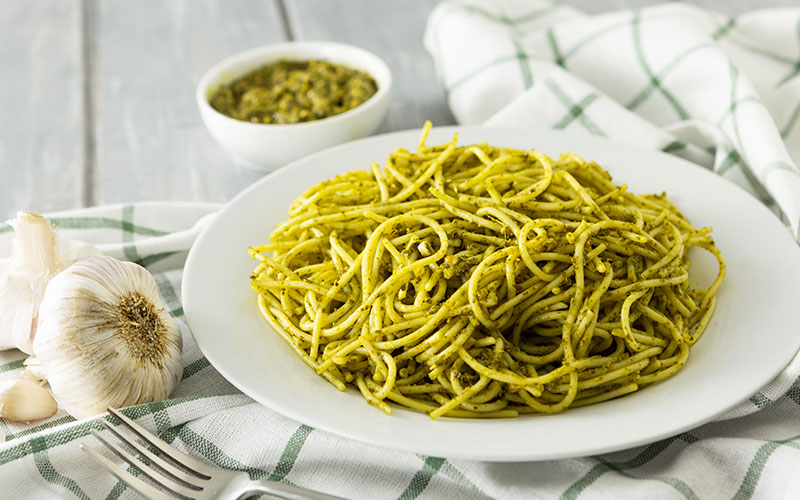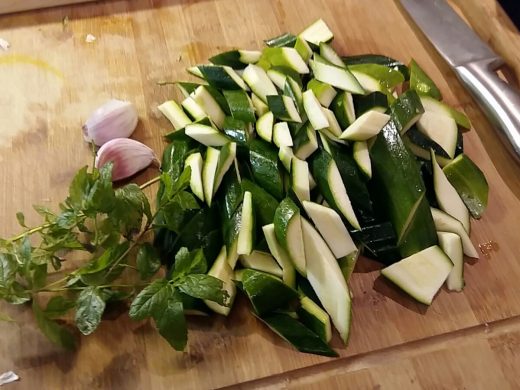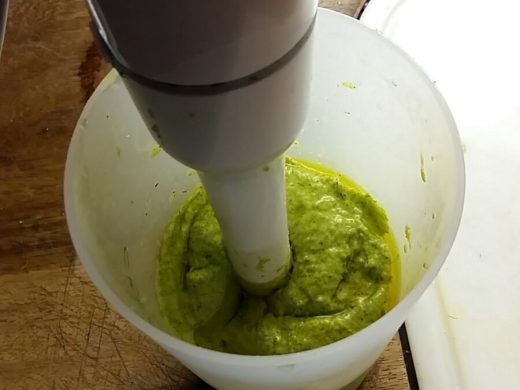WHOLEGRAIN SPAGHETTI WITH ZUCCHINI PESTO, FLOWERS AND PINE NUTS

INGREDIENTS
- 480g whole-grain spaghetti
- 400g novel zucchini
- 300g medium sized zucchini
- 100g pine nuts and/or shelled almonds
- 3 Tbsp grated Parmesan cheese
- 50g Mint
- 6 zucchini flowers
- 1 lemon
- Extra virgin olive oil
- Salt and Pepper
NUTRITIONAL VALUE
- Energy value: 425 kcal (portion)
- Features: Rich in fiber (11.5 g), mineral salts, vitamins and mono-unsaturated and poli-unsaturated fatty acids
METHOD


Cut the novel zucchini in half. Place them a baking tray. Add salt, olive oil and bake at 180 degrees C for 30-35 mins. Remove from oven let cool. Blend with 80g of olive oil, lemon juice, a few mint leaves, some pine nuts, (keep aside some pine nuts and toast a few for garnishing at end of cooking) 3 tablespoons of grated parmesan cheese ,20 g of water and salt and pepper. Blend well to obtain the pesto.
Cut the medium sized zucchini with mandolin cutter to obtain ‘julienne’ shape. Place them in frying pan with 3 tablespoons of olive oil and cook until they are ‘al dente’. Add salt, mint leaves and half a lemon zest. In the meantime, cook pasta and drain. Add cooked pasta to zucchini in pan and cook together for a few minutes. Place pasta and cooked zucchini in a bowl. Add the pesto, toasted pine nuts and zucchini flower (without pistils).
It’s delicious!
PROPERTIES
Some of the ingredients in the recipe can help in the case of constipation: whole meal pasta, pine nuts and zucchini contain fiber which can help to regularize the intestinal motility.
The whole meal pasta comes from wholegrain hard wheat flour which is obtained from grinding the whole grain (bran, germ and endosperm). Bran and germ provide fiber, minerals, proteins, vitamin B and essential fatty acids. Hard wheat pasta, on the other hand, is made with flour obtained from the grinding of just the endosperm which contains mainly starch and protein.
Pine nuts, in addition to providing a good source of fiber (4, 5 g /100g) also provide energy thanks to the high content in proteins and mono and poly fatty acids unsaturated. They contain a high intake of magnesium and help to improve fatigue.
Compared to the previous two ingredients, zucchini have a lower intake of fiber. However, they help to regulate the intestinal function. They are easily digested and are rich in vitamins and minerals. They can be stewed, steamed or baked.
BE CAREFUL WHILE CHOOSING WHOLEMEAL FOOD PRODUCTS
It is essential to know how to recognize a truly wholemeal product. Do not be fooled by the darker color of the food or by the declaration of a high fiber content on the packaging as these features do not a guarantee ‘wholemeal’.
It is important to read the label carefully. If you read on the food package: ‘with bran’ ‘stone-ground’ ‘cereals’ or ‘100% wheat’, it does not necessarily indicate that the product is whole meal. To be sure that a product is whole meal, we need to make sure that it is made from whole grains.
A high fiber content may not be a guarantee of overall wholemeal product as refined flours may have been used. The part of seed which is rich in fiber is later added. Such products should not be defined as wholemeal as they do not contain the germ.
A dark color does not guarantee that a food is made from whole grains. For example, caramel or molasses dyes can be added to bread to give it a darker colour. However, it may have been made from white flours and not from the whole grains.


